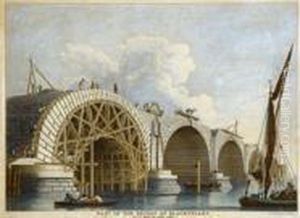Eduard Rooker Paintings
Eduard Rooker, also known as Edward Rooker, was an English artist born in London in 1712. He was primarily known for his work as an engraver and printmaker but was also skilled in theatrical scenery painting. Rooker descended from a Dutch family that settled in England in the late 17th century. His father, Michael Rooker, also known as Michiel Rooker, was a Dutch-born painter who had moved to London, where Eduard was born and raised.
During his career, Eduard Rooker collaborated with several prominent artists of his time. He is well-recognized for his work with the English landscape painter Paul Sandby. Together, they produced a set of engravings titled 'Twelve Views in Aquatinta from Drawings Taken on the Spot in South Wales,' which were published in 1775, after Rooker's death. These prints were some of the earliest examples of aquatint, a form of etching that allowed for a more painterly representation of tone and texture, a technique that was relatively new at the time.
Rooker's engravings and prints often featured architectural subjects, including views of ruins and buildings, which were popular with the Grand Tour travelers of the 18th century. He was particularly adept at depicting light and shadow, bringing a dramatic atmosphere to his works. His attention to detail and ability to capture the essence of architectural structures made his prints sought after for their accuracy and artistry.
Aside from his prints, Eduard Rooker also made a name for himself in the world of theatre. He painted scenery for the Theatre Royal in London and was involved in the design and execution of stage sets. This theatrical influence is evident in the composition and perspective of many of his prints, which often feature a dramatic sense of depth and staging.
Eduard Rooker passed away in 1774 in London. Although he may not be as widely remembered as some of his contemporaries, his contributions to the art of engraving and printmaking, particularly in the use of aquatint, have secured him a place in the history of British art. His works continue to be appreciated by collectors and art historians for their technical skill and historical value.



